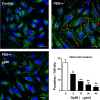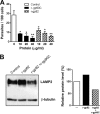Inhibition of Host Cell Lysosome Spreading by Trypanosoma cruzi Metacyclic Stage-Specific Surface Molecule gp90 Downregulates Parasite Invasion
- PMID: 28607099
- PMCID: PMC5563561
- DOI: 10.1128/IAI.00302-17
Inhibition of Host Cell Lysosome Spreading by Trypanosoma cruzi Metacyclic Stage-Specific Surface Molecule gp90 Downregulates Parasite Invasion
Abstract
Successful infection by Trypanosoma cruzi, the agent of Chagas' disease, is critically dependent on host cell invasion by metacyclic trypomastigote (MT) forms. Two main metacyclic stage-specific surface molecules, gp82 and gp90, play determinant roles in target cell invasion in vitro and in oral T. cruzi infection in mice. The structure and properties of gp82, which is highly conserved among T. cruzi strains, are well known. Information on gp90 is still rather sparse. Here, we attempted to fill that gap. gp90, purified from poorly invasive G strain MT and expressing gp90 at high levels, inhibited HeLa cell lysosome spreading and the gp82-mediated internalization of a highly invasive CL strain MT expressing low levels of a diverse gp90 molecule. A recombinant protein containing the conserved C-terminal domain of gp90 exhibited the same properties as the native G strain gp90: it counteracted the host cell lysosome spreading induced by recombinant gp82 and exhibited an inhibitory effect on HeLa cell invasion by CL strain MT. Assays to identify the gp90 sequence associated with the property of downregulating MT invasion, using synthetic peptides spanning the gp90 C-terminal domain, revealed the sequence GVLYTADKEW. These data, plus the findings that lysosome spreading was induced upon HeLa cell interaction with CL strain MT, but not with G strain MT, and that in mixed infection CL strain MT internalization was inhibited by G strain MT, suggest that the inhibition of target cell lysosome spreading is the mechanism by which the gp90 molecule exerts its downregulatory role.
Keywords: Trypanosoma cruzi; host cell invasion.
Copyright © 2017 Rodrigues et al.
Figures





References
-
- Schmunis GA, Yadon ZE. Chagas disease: a Latin American health problem becoming a world health problem. Acta Trop 115:14–21. - PubMed
Publication types
MeSH terms
Substances
LinkOut - more resources
Full Text Sources
Other Literature Sources
Miscellaneous

